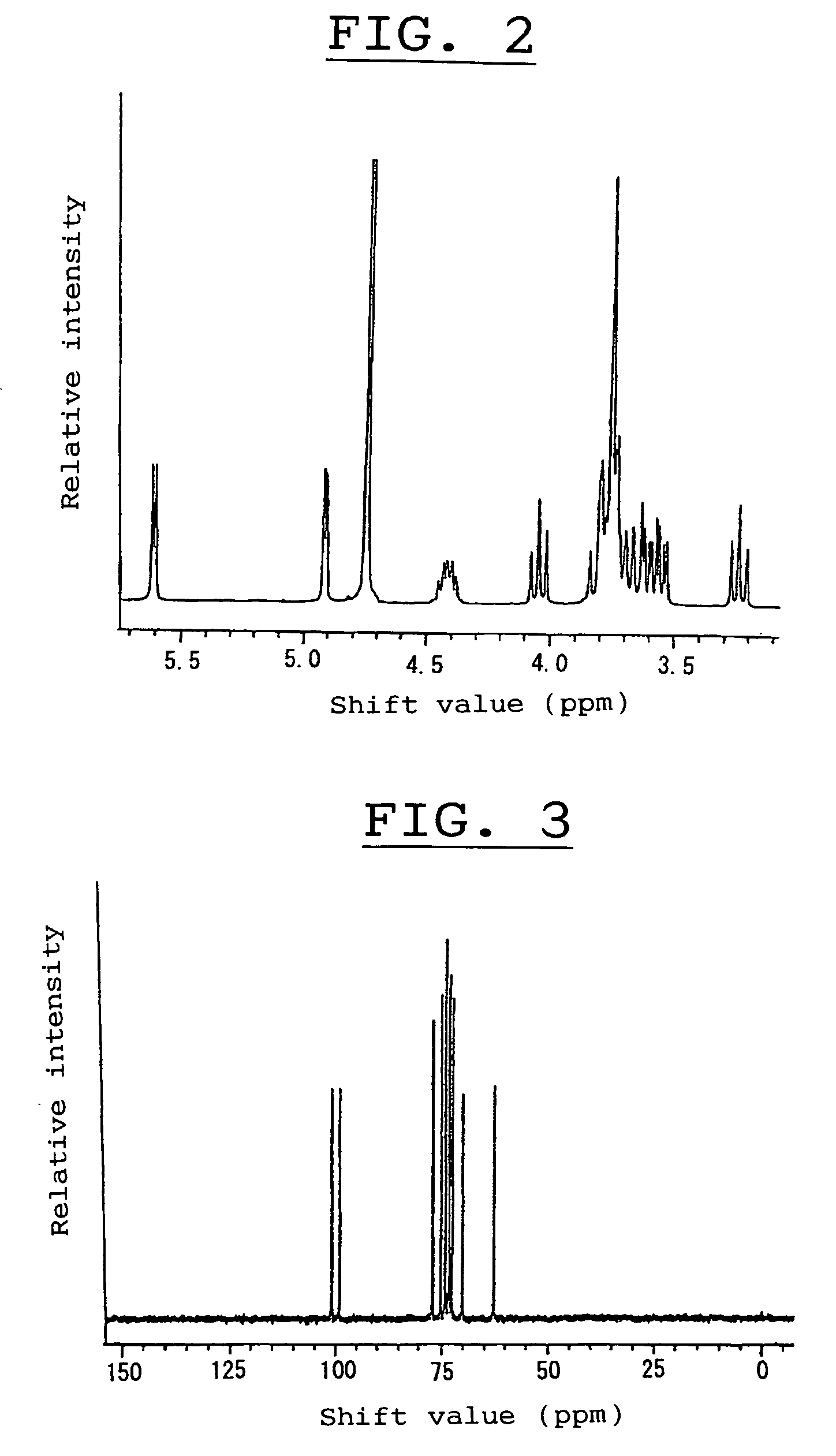α-Isomaltosyltransferase, process for producing the same and use thereof
a technology of isomaltosyltransferase and isomaltosyltransferase, which is applied in the field of isomaltosyltransferase, can solve the problems of difficult availability of microorganisms for producing alternan and alternanase, material alternan and alternanase as an enzyme, and achieve satisfactory thermal and ph stability, easy collection, and mild and lesser sweetness
- Summary
- Abstract
- Description
- Claims
- Application Information
AI Technical Summary
Benefits of technology
Problems solved by technology
Method used
Image
Examples
experiment 1
Preparation of Non-reducing Cyclotetrasaccharide by Culturing
[0269]A liquid medium consisting of 5% (w / v) of panose, produced by Hayashibara Biochemical Laboratories Inc., Okayama, Japan, 1.5% (w / v) of “ASAHIMEAST”, a yeast extract commercialized by Asahi Breweries, Ltd., Tokyo, Japan, 0.1% (w / v) of dipotassium phosphate, 0.06% (w / v) of sodium phosphate dodecahydrate, 0.05% (w / v) magnesium sulfate heptahydrate, and water was placed in a 500-ml Erlenmeyer flask in an amount of 100 ml, sterilized by autoclaving at 121° C. for 20 min, cooled, and then seeded with Bacillus globisporus C9 strain, FERM BP-7143, followed by culturing under rotary-shaking conditions at 27° C. and 230 rpm for 48 hours and centrifuging the resulting culture to remove cells to obtain a supernatant. The supernatant was autoclaved at 120° C. for 15 min and then cooled, and the resulting insoluble substances were removed by centrifugation to obtain a supernatant.
[0270]To examine the saccharides in the supernatant...
experiment 2
Structural Analysis of Non-reducing Saccharide
[0274]Fast atom bombardment mass spectrometry (called “FAB-MS”) of a non-reducing saccharide, obtained by the method in Experiment 1, clearly detected a proton-addition-molecular ion with a mass number of 649, meaning that the saccharide had a mass number of 648.
[0275]According to conventional manner, the saccharide was hydrolyzed with sulfuric acid and then analyzed for sugar composition. As a result, only D-glucose molecules were detected, revealing that the saccharide was composed of D-glucose molecules for forming a cyclic tetrasaccharide composed of four D-glucose molecules in view of the above mass number.
[0276]Nuclear magnetic resonance analysis (abbreviated as “NMR” hereinafter) of the saccharide gave a 1H-NMR spectrum as shown in FIG. 2 and a 13C-NMR spectrum as shown in FIG. 3, and these spectra were compared with those of known saccharides, revealing that the spectra of the saccharide were coincided with those of a non-reducin...
experiment 3
Production of α-isomaltosyl-transferring Enzyme from Bacillus globisporus C9
[0277]A liquid culture medium consisting of 4.0% (w / v) of “PINE-DEX #4”, a partial starch hydrolysate commercialized by Matsutani Chemical Ind., Tokyo, Japan, 1.8% (w / v) of “ASAHIMEAST”, a yeast extract commercialized by Asahi Breweries, Ltd., Tokyo, Japan, 0.1% (w / v) of dipotassium phosphate, 0.06% (w / v) of sodium phosphate dodecahydrate, 0.05% (w / v) magnesium sulfate heptahydrate, and water was placed in 500-ml Erlenmeyer flasks in respective volumes of 100 ml, sterilized by autoclaving at 121° C. for 20 min, cooled, and then seeded with Bacillus globisporus C9 strain, FERM BP-7143, followed by culturing under rotary-shaking conditions at 27° C. and 230 rpm for 48 hours for a seed culture.
[0278]About 20 L of a fresh preparation of the same liquid culture medium as used in the above seed culture were placed in a 30-L fermentor, sterilized by heating, and then cooled to 27° C. and inoculated with one percent...
PUM
 Login to View More
Login to View More Abstract
Description
Claims
Application Information
 Login to View More
Login to View More - R&D
- Intellectual Property
- Life Sciences
- Materials
- Tech Scout
- Unparalleled Data Quality
- Higher Quality Content
- 60% Fewer Hallucinations
Browse by: Latest US Patents, China's latest patents, Technical Efficacy Thesaurus, Application Domain, Technology Topic, Popular Technical Reports.
© 2025 PatSnap. All rights reserved.Legal|Privacy policy|Modern Slavery Act Transparency Statement|Sitemap|About US| Contact US: help@patsnap.com



